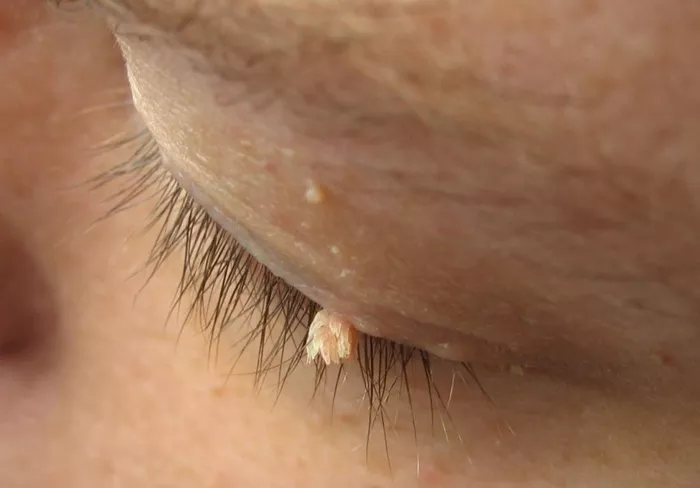Warts are benign growths on the skin caused by the human papillomavirus (HPV). They can appear anywhere on the body, including sensitive areas like under the eyes. Filiform warts, which are long and slender, often develop around facial features and can be particularly bothersome due to their visibility and location. While warts are generally harmless, many individuals seek to remove them for cosmetic reasons or discomfort. This article provides a comprehensive guide on how to effectively remove warts located under the eye, discussing various treatment options, their efficacy, and potential side effects.
Understanding Warts
What Are Warts?
Warts are small, rough growths that can occur on the skin. They are caused by an infection with HPV, which triggers rapid growth of cells on the outer layer of skin. Warts can vary in appearance:
Common warts: Rough, raised bumps typically found on fingers or hands.
Plantar warts: Found on the soles of the feet and can be painful.
Flat warts: Smaller and smoother than other types, often occurring in large numbers.
Filiform warts: Long and narrow warts that usually appear on the face or neck.
Types of Warts Under the Eye
The warts that develop under the eye are often filiform warts. These can be particularly noticeable due to their location and may cause emotional distress for some individuals. Understanding their characteristics is crucial for effective treatment.
Treatment Options for Warts Under the Eye
When it comes to removing warts under the eye, several treatment options are available. Each method has its own advantages and disadvantages, and the choice of treatment often depends on factors such as wart type, size, location, and individual patient preferences.
1. Cryotherapy
Cryotherapy involves freezing the wart with liquid nitrogen. This method is commonly used by dermatologists for various types of warts.
Procedure: The doctor applies liquid nitrogen to the wart using a spray or cotton swab. The freezing process destroys the wart tissue.
Efficacy: Multiple treatments may be necessary for complete removal.
Side Effects: Possible side effects include pain during treatment, blistering, and changes in skin color.
2. Electrosurgery
Electrosurgery uses electrical currents to burn off wart tissue.
Procedure: A healthcare provider uses a device that generates high-frequency electrical currents to heat and destroy wart tissue.
Efficacy: This method is effective for larger or more stubborn warts.
Side Effects: Risks include scarring and potential pain during recovery.
3. Cantharidin Treatment
Cantharidin is a blistering agent that can be applied directly to the wart.
Procedure: The doctor applies cantharidin to the wart, causing a blister to form underneath it. After a few days, the blister is removed along with the wart.
Efficacy: This method is effective but may not be suitable for all patients due to potential blistering.
Side Effects: Pain from blister formation and possible skin irritation.
4. Topical Treatments
Topical treatments involve applying medication directly to the wart.
Common Medications:
- Salicylic acid: Softens and gradually removes layers of skin.
- Imiquimod: Stimulates the immune system to fight off HPV.
- 5-fluorouracil: A chemotherapy agent that helps peel away skin cells.
Procedure: These medications are applied as creams or gels over several weeks.
Efficacy: Results may take time; consistency is key for effectiveness.
Side Effects: Skin irritation or allergic reactions may occur.
5. Surgical Removal
In some cases, surgical removal may be necessary.
Procedure: A dermatologist uses a scalpel or other instruments to cut out the wart.
Efficacy: This method provides immediate results but may require stitches if deeper layers of skin are involved.
Side Effects: Scarring is a potential risk with surgical removal.
6. Immunotherapy
Immunotherapy stimulates the body’s immune response against HPV.
Procedure: This may involve injections of substances like candida antigen into or around the wart.
Efficacy: It may take several weeks or months to see results as it relies on boosting immune function.
Side Effects: Itching or irritation at injection sites.
Home Remedies
Some individuals opt for home remedies before seeking professional treatment. While these methods may not be as effective as medical treatments, they can provide relief for minor cases.
1. Salicylic Acid
Salicylic acid is available over-the-counter in various forms such as gels or pads.
Usage: Apply directly to the wart after soaking in warm water to soften it.
Considerations: Consistent application over several weeks is necessary for results.
2. Duct Tape Method
This unconventional method involves covering the wart with duct tape.
Usage: Place a piece of duct tape over the wart for six days; then remove it and soak in water before gently scraping off dead tissue.
Considerations: Repeat until the wart disappears; results vary widely among individuals.
3. Apple Cider Vinegar
Some people use apple cider vinegar as a natural remedy due to its acidic properties.
Usage: Soak a cotton ball in apple cider vinegar and apply it to the wart overnight.
Considerations: Skin irritation may occur; use cautiously around sensitive areas like under the eyes.
When to See a Doctor
It’s essential to consult a healthcare professional if:
- The wart changes in appearance (color, size).
- You experience pain or discomfort in the area.
- The wart persists despite home treatments.
- You have multiple warts or a history of HPV-related issues.
Conclusion
Removing a wart under the eye can significantly improve one’s appearance and self-esteem. While various treatment options exist—from cryotherapy and electrosurgery to topical treatments—consulting with a dermatologist is crucial for determining the most appropriate method based on individual circumstances. Home remedies may offer some relief but should not replace professional advice when dealing with facial warts. Always prioritize safety and efficacy when considering treatment options for warts under sensitive areas like the eyes.
Related topic:
How Does PRP Treatment Remove Bags Under The Eyes?
Top 5 Home Remedies for Warts Under the Eyes
How To Get Rid Of Spider Veins Under Eyes?

